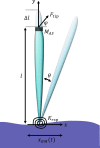A minimal physics-based model for musical perception
- PMID: 36693091
- PMCID: PMC9945942
- DOI: 10.1073/pnas.2216146120
A minimal physics-based model for musical perception
Abstract
Some people, entirely untrained in music, can listen to a song and replicate it on a piano with unnerving accuracy. What enables some to "hear" music so much better than others? Long-standing research confirms that part of the answer is undoubtedly neurological and can be improved with training. However, are there structural, physical, or engineering attributes of the human hearing mechanism apparatus (i.e., the hair cells of the internal ear) that render one human innately superior to another in terms of propensity to listen to music? In this work, we investigate a physics-based model of the electromechanics of the hair cells in the inner ear to understand why a person might be physiologically better poised to distinguish musical sounds. A key feature of the model is that we avoid a "black-box" systems-type approach. All parameters are well-defined physical quantities, including membrane thickness, bending modulus, electromechanical properties, and geometrical features, among others. Using the two-tone interference problem as a proxy for musical perception, our model allows us to establish the basis for exploring the effect of external factors such as medicine or environment. As an example of the insights we obtain, we conclude that the reduction in bending modulus of the cell membranes (which for instance may be caused by the usage of a certain class of analgesic drugs) or an increase in the flexoelectricity of the hair cell membrane can interfere with the perception of two-tone excitation.
Keywords: flexoelectricity; mechanics; music; soft matter.
Conflict of interest statement
The authors declare no competing interest.
Figures











Similar articles
-
Piano training enhances the neural processing of pitch and improves speech perception in Mandarin-speaking children.Proc Natl Acad Sci U S A. 2018 Jul 10;115(28):E6630-E6639. doi: 10.1073/pnas.1808412115. Epub 2018 Jun 25. Proc Natl Acad Sci U S A. 2018. PMID: 29941577 Free PMC article. Clinical Trial.
-
Music and lexical tone perception in Chinese adult cochlear implant users.Laryngoscope. 2012 Jun;122(6):1353-60. doi: 10.1002/lary.23271. Epub 2012 Feb 23. Laryngoscope. 2012. PMID: 22362607
-
Can You Hear Out the Melody? Testing Musical Scene Perception in Young Normal-Hearing and Older Hearing-Impaired Listeners.Trends Hear. 2020 Jan-Dec;24:2331216520945826. doi: 10.1177/2331216520945826. Trends Hear. 2020. PMID: 32895034 Free PMC article.
-
Can nonlinguistic musical training change the way the brain processes speech? The expanded OPERA hypothesis.Hear Res. 2014 Feb;308:98-108. doi: 10.1016/j.heares.2013.08.011. Epub 2013 Sep 20. Hear Res. 2014. PMID: 24055761 Review.
-
Influence of musical expertise and musical training on pitch processing in music and language.Restor Neurol Neurosci. 2007;25(3-4):399-410. Restor Neurol Neurosci. 2007. PMID: 17943015 Review.
Cited by
-
Potential common targets of music therapy intervention in neuropsychiatric disorders: the prefrontal cortex-hippocampus -amygdala circuit (a review).Front Hum Neurosci. 2025 Feb 3;19:1471433. doi: 10.3389/fnhum.2025.1471433. eCollection 2025. Front Hum Neurosci. 2025. PMID: 39963392 Free PMC article. Review.
-
The giant flexoelectric effect in a luffa plant-based sponge for green devices and energy harvesters.Proc Natl Acad Sci U S A. 2023 Oct 3;120(40):e2311755120. doi: 10.1073/pnas.2311755120. Epub 2023 Sep 25. Proc Natl Acad Sci U S A. 2023. PMID: 37748078 Free PMC article.
References
-
- Rossing T. D., The Science of Sound (Addison-Wesley Publishing Company, 1982).
-
- Jones M. R., et al. , Music Perception: Current Research and Future Directions. Music Perception (Springer-Verlag, New York, 2010).
-
- Gelfand S. A., Hearing: An Introduction to Psychological and Physiological Acoustics (CRC Press, 2017).
-
- Hudspeth A., Integrating the active process of hair cells with cochlear function. Nat. Rev. Neurosci. 15, 600–614 (2014). - PubMed
Publication types
MeSH terms
LinkOut - more resources
Full Text Sources
Research Materials

